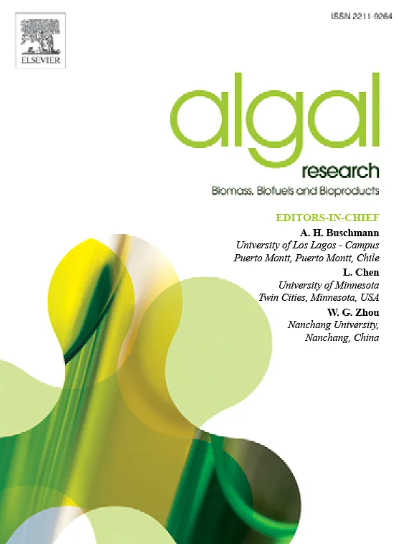Unlocking biochemical profile of Chaetoceros calcitrans, Cylindrotheca fusiformis, and Nannofrustulum shiloi (Bacillariophyta) for nutritional and added-value applications
IF 4.6
2区 生物学
Q1 BIOTECHNOLOGY & APPLIED MICROBIOLOGY
Algal Research-Biomass Biofuels and Bioproducts
Pub Date : 2025-05-05
DOI:10.1016/j.algal.2025.104080
引用次数: 0
Abstract
Diatoms have garnered attention as sources of natural bioactive compounds, making them attractive for developing high-value products for different biotechnological ends, particularly for nutritional applications. Despite their potential, the chemical composition of industrially produced biomass remains largely underexplored. In this context, this study was focused on a thorough characterisation of the biochemical profile of three marine diatom species produced outdoors in photobioreactors: Chaetoceros calcitrans, Cylindrotheca fusiformis, and Nannofrustulum shiloi. The proximal composition of biomasses accounted for 29–35 % ashes, 21–30 % proteins, 7–14 % lipids, 3–7 % carbohydrates, and 0.4–2 % pigments. Each species contained >35 % of essential amino acids, mainly alanine and leucine. Distinct soluble protein and peptide size distribution patterns were observed among the three species. Galactose (26–45 mol%), uronic acids (20–29 mol%), and glucose (3–21 mol%) were the main sugar residues found in all species. Galactose was mainly derived from floridoside and related compounds. The most abundant fatty acid was 20:5 n-3 in C. calcitrans (18 %), whereas in C. fusiformis was 16:1 n-7 (20 %) and 16:0 in N. shiloi (21 %). Lipidomics revealed 325 species of glycolipids, phospholipids, betaine lipids, sphingolipids, fatty amides, and sterol lipids, also with a distinct distribution along the lipid classes. C. calcitrans was the richest in chlorophylls (14 mg.g−1) and carotenoids (8 mg.g−1). In mineral analysis, calcium showed the highest difference, 66 mg.g−1 in N. shiloi, 27 mg.g−1 in C. fusiformis, and 4 mg.g−1 in C. calcitrans. Overall, this study highlights the nutritional potential of industrially produced diatoms, with distinct chemical profile that can be explored for target applications.
揭示钙化毛藻、梭形圆柱毛藻和硅藻的生化特征,用于营养和增值应用
硅藻作为天然生物活性化合物的来源引起了人们的注意,这使得它们对开发用于不同生物技术目的的高价值产品具有吸引力,特别是在营养应用方面。尽管它们具有潜力,但工业生产的生物质的化学成分在很大程度上仍未得到充分开发。在此背景下,本研究的重点是全面表征在户外光生物反应器中生产的三种海洋硅藻物种的生化特征:角化毛藻、梭状圆柱藻和石洛纳米藻。生物质的主要成分为灰分29 - 35%,蛋白质21 - 30%,脂质7 - 14%,碳水化合物3 - 7%,色素0.4 - 2%。每个物种都含有35%的必需氨基酸,主要是丙氨酸和亮氨酸。可溶性蛋白和多肽的大小分布规律在3种植物中有明显差异。半乳糖(26-45 mol%)、醛酸(20-29 mol%)和葡萄糖(3-21 mol%)是所有物种中发现的主要糖残基。半乳糖主要来源于花草苷及其相关化合物。其中,钙钙藤的脂肪酸含量最高,为20:5 n-3(18%),而梭形藤的脂肪酸含量最高,为16:1 n-7(20%),石竹的脂肪酸含量最高,为16:0(21%)。脂质组学揭示了325种糖脂、磷脂、甜菜碱脂、鞘脂、脂肪酰胺和甾醇脂,也具有明显的脂类分布。C. calcitrans中叶绿素含量最高(14 mg.g−1),类胡萝卜素含量最高(8 mg.g−1)。在矿物分析中,钙的差异最大,为66 mg。g−1 in N. shiloi, 27 mg。g−1,4 mg。g−1。总的来说,这项研究强调了工业生产的硅藻的营养潜力,具有独特的化学特征,可以探索目标应用。
本文章由计算机程序翻译,如有差异,请以英文原文为准。
求助全文
约1分钟内获得全文
求助全文
来源期刊

Algal Research-Biomass Biofuels and Bioproducts
BIOTECHNOLOGY & APPLIED MICROBIOLOGY-
CiteScore
9.40
自引率
7.80%
发文量
332
期刊介绍:
Algal Research is an international phycology journal covering all areas of emerging technologies in algae biology, biomass production, cultivation, harvesting, extraction, bioproducts, biorefinery, engineering, and econometrics. Algae is defined to include cyanobacteria, microalgae, and protists and symbionts of interest in biotechnology. The journal publishes original research and reviews for the following scope: algal biology, including but not exclusive to: phylogeny, biodiversity, molecular traits, metabolic regulation, and genetic engineering, algal cultivation, e.g. phototrophic systems, heterotrophic systems, and mixotrophic systems, algal harvesting and extraction systems, biotechnology to convert algal biomass and components into biofuels and bioproducts, e.g., nutraceuticals, pharmaceuticals, animal feed, plastics, etc. algal products and their economic assessment
 求助内容:
求助内容: 应助结果提醒方式:
应助结果提醒方式:


